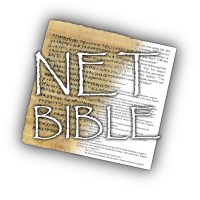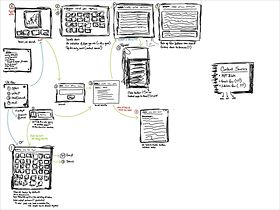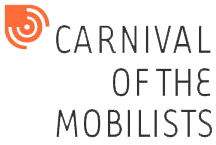 A few years ago, I was in San Diego for a conference and entered into a conversation with a gentleman who wanted to know more about MMM. Of the questions that he asked, one of them that was one part shocking, but another part (quickly) introspective was whether MMM also serves the Jewish community who would like to also participate in this conversation about faith and mobile devices? Don’t get me wrong, I know completly the (American Protestant) Christian slant to things here, but it wasn’t clear until then if such a perspective was a determent or a benefit towards things. After that conversation, I grappled with the implications of my answer to him (we aren’t a respecter of religions, but are careful in every approach taken), and what that should mean going forward. This past November/December, that context came up again – but in the guise of an application (and its resulting conversations) and an experiment.
A few years ago, I was in San Diego for a conference and entered into a conversation with a gentleman who wanted to know more about MMM. Of the questions that he asked, one of them that was one part shocking, but another part (quickly) introspective was whether MMM also serves the Jewish community who would like to also participate in this conversation about faith and mobile devices? Don’t get me wrong, I know completly the (American Protestant) Christian slant to things here, but it wasn’t clear until then if such a perspective was a determent or a benefit towards things. After that conversation, I grappled with the implications of my answer to him (we aren’t a respecter of religions, but are careful in every approach taken), and what that should mean going forward. This past November/December, that context came up again – but in the guise of an application (and its resulting conversations) and an experiment.
An Application and A Conversation
I’m not sure exactly how I stumbled upon it, but there was a conversation about the Mishkan T’filah iPad app that had been developed and released, and I found myself studying the conversation around it.
From the CCAR website:
Mishkan T’filah is the siddur used by congregations throughout the world…
Like the print version of Mishkan T’filah, the prayers in iT’filah are fully transliterated, and are accompanied by many inspiring readings and commentary. Move between prayers and explore additional content with the swipe of a finger. Tap to hear many of the prayers chanted or read aloud.
This first version of iT’filah contains the Erev Shabbat (Friday Night) Service, with accompanying page numbers corresponding to the print editions of Mishkan T’filah. Future releases will include even more content, such as Shabbat (Saturday) Morning and home blessings, and will be also be available on the iPhone and iPod.
The iT’filah (The Mishkan T’filah App) can be downloaded from the iTunes store.
But, it was the conversation around that app – literally its implications – that got me stuck on this topic again. At Frume Sarah’s website probably the best stream of conversations on the iT’filah and how ebooks challenge traditional thoughts about the Sabbath. Here’s a snippet of some of the opinions being grappled with (comment by EdibleTorah):
I find myself standing with you and against you.
As an IT professional (ie: computer geek), I think anything that CAN be an app SHOULD be an app. I like having my siddur on my droid phone – three different ones, in fact. I love all the various Jewish tools my technology makes possible, from the “which way is Jerusalem” compass to the “zman minder” popup that let’s me know when i’m 30 minutes away from the daily davening (praying) deadline.
And as an orthodox Jew, it all gets shut off on Shabbat. Every last bit, byte, checkin, update and tweet. Which is fine. One day out of 7, I can live without it, I can hug my hardcover Artscroll to my chest as I pray, and enjoy the pure analog experience of it all.
*IF* your one day (or your main day, or the day you are sure you can make time) to pray is Shabbat, then I can see where there would be cognitive dissonance.
But if not, then I think there is room for (and benefit to) both.
Clearly, this is no different than what we’ve been conversing about for several years now. With the change of media to connected, electronic streams, it does challenge traditional thoughts about what’s beneficial and what remains holy (yes, I know that Christians can step in here with the “Sabbath was made for man, not man for the Sabbath” verse, but I’d rather not get confrontational right now – merely just highlighting the conversation streams we share).
In the meantime, we have added the iT’filah app to our (renamed) Bibles and Religious Apps for Mobile page. There’s more that should be highlighted there that would be of value to all. Feel free to submit your app to us if you would like it noted on that page.
An AR Experiment
The second poke to this stream came as I was reading the website of a recent contributor to the Carnival of the Mobilists, Mobile in DC. He simply did a quick application using an augmented reality API made available by Qualcomm to .
Its just an experiment, but it does revisit the classic discussion of icons and sacraments. If someone can utilize a mobile to transform a static space into something of a holy altar (or altar of remembrance), then does the personal interpretation of faith take on a different, heavier weight than that of the community-hewn vision of faith? If, a person is able to program (build) their temple, does the worship space, or even the prayer closet, take on a a looser definition? Or, does its effectiveness towards drawing one closer to the goals of that faith increase/diminish?
The Relevance of These Viewpoints
Why is this signifiant? Well, look at both of the contexts noted in this piece. You have the first where the intrusion of digital literature changes – or at the very least challenges – the behaviors of faith curated by time and tradition. And then you have the second which observes the memorial space which, but does so through the lens of virtual reality, not a physical icon. Unlike our discussion earlier about the (possible) headless faith of file sharing, we have here a challenge to a faith’s confidence to remain holy while embracing new behaviors and perceptions.
We can’t make the statement that the implications of digital artifacts (web, mobile, AR, etc.) are to be ignored. But, perhaps we might need to do a better job of sharing the insights of our conversations towards figuring out what this is all about. To some extent, a few of us are grafted into the same tree of faith, therefore what happens to one branch has an effect on the entire tree.

![[Screenshot] MobMin.Info (from iPad) - Share on Ovi [Screenshot] MobMin.Info (from iPad) - Share on Ovi](http://media.share.ovi.com/m1/lt/3260/2e42c33b850443a5905da4d1fff8b284.jpg)
 Last fall, I was (electronically) introduced to a brother from the company
Last fall, I was (electronically) introduced to a brother from the company  Technically, it’s the last week of the year and I am supposed to be on vacation. It not felt needed to be taking this time off, but even felt that unction from the Lord that I really needed to set this aside and just breathe a bit.
Technically, it’s the last week of the year and I am supposed to be on vacation. It not felt needed to be taking this time off, but even felt that unction from the Lord that I really needed to set this aside and just breathe a bit.



 Of the news items of note so far this year, and interesting one came across my RSS reader
Of the news items of note so far this year, and interesting one came across my RSS reader